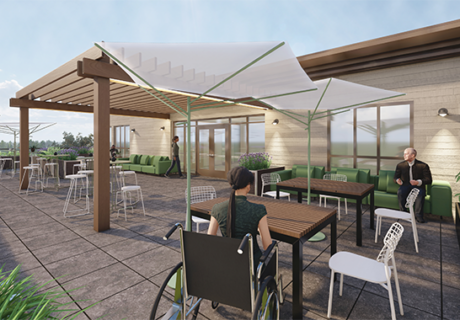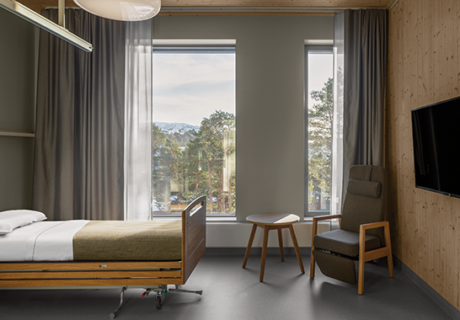Understanding Aging To Create Senior-Friendly Healthcare Spaces
Evidence-based design research is largely associated with aspects of the built environment that support satisfaction and outcomes of the general patient population. But little information exists that’s tied to the very specific segment of the population age 65 and up.
That’s what the design team behind Yale-New Haven Hospital’s new Center for Restorative Care discovered when digging into available findings to help shape the senior-centered unit.
Previously housed on an older med/surg patient floor of the New Haven, Conn., hospital, the center was moved to a renovated floor that matches thoughtful architecture and signage with clinical care to support older patients. Opened in October 2014, the unit provides care to inpatients 65 and older, offering a team of specially trained physicians, nurses, physical and occupational therapists, social workers, nutritionists, and care coordinators who ensure that patients remain as functional as possible during their stay.
While there wasn’t a lot of design-specific information available regarding seniors to go on, plenty of researchers had explored the effects of aging in other ways. For example, says James Wisniewski, senior associate at Michael Graves Architecture & Design (MGA&D; Princeton, N.J.), there was much to learn about how eyesight and vision is affected by age. MGA&D served as the interior design architect and collaborated on the overall design with Shepley Bulfinch (Boston), which was the architect of record.
“Most of the data came from ophthalmologists and their research. We took their data and applied it to the built environment,” Wisniewski says. “As you age, you need more light to determine contrast, and yet in most patient rooms, the lighting in the room (other than the exam light over the bed) doesn’t provide enough light to adequately see the transition between patient room flooring and the patient toilet room flooring, contributing to increased falls by seniors in the toileting process.”
The team found in its research that as the eye ages, the cornea begins to yellow and cause colors to fade to a monochromatic beige, a fact that placed lighting at the top of the project priority list. “We incorporated lighting fixtures with brighter footcandles, in order to allow seniors to see the full spectrum of color. We used brighter colors and incorporated clear color contrast at flooring transitions,” Wisniewski says.
Creating the right acoustics was also important in the unit design. For example, carpet was chosen for patient corridors to reduce the traditional din heard outside patient room walls, but it was completed with a pattern that patients and their physical therapists could use as walking milestones to encourage exercise and, hopefully, reduce lengths of stay.
Clear wayfinding was also a hallmark of the program, with the designers consulting clinical staff to understand what information was important to display and where there were shortcomings in signage at the existing location. “The design team developed a patented signage program that helps educate visitors to required protocols. Clinicians appreciate the clarity, as well,” Wisniewski says.
While the Yale-New Haven project was a senior-specific unit, the endeavor provided plenty of food for thought regarding how those same principles could be applied across healthcare spaces.
“One of the biggest lessons we learned from the process was that design solutions developed to assist an elderly population, when done well and integrated elegantly into the environment, could easily be implemented in all patient environments and not carry the stigma associated with handicapped design,” Wisniewski says.
Research on how the unit design is performing is being conducted, to be shared at a later date. However, in the meantime, Wisniewski will be joined by project team members Dr. Lisa Walke, associate professor of medicine (geriatrics) and associate chief for clinical affairs (geriatrics) at Yale School of Medicine, and Mario Vieira, principal at Shepley Bulfinch, to discuss the project and its results so far at the Environments for Aging Conference, April 18-21 in Baltimore, in the session “Design Strategies to Support a Geriatric Center of Excellence.” For more information, visit EFAconference.com.
Jennifer Kovacs Silvis is executive editor of Healthcare Design. She can be reached at jsilvis@vendomegrp.com.




